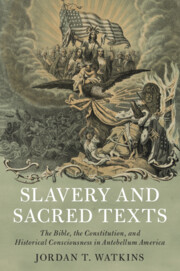 Slavery and Sacred Texts
Slavery and Sacred Texts Book contents
- Slavery and Sacred Texts
- Cambridge Historical Studies in American Law and Society
- Slavery and Sacred Texts
- Copyright page
- Dedication
- Contents
- Acknowledgments
- Prologue
- Introduction
- 1 “Recourse Must Be Had to the History of Those Times”
- 2 “The Ground Will Shake”
- 3 “Texts … Designed for Local and Temporary Use”
- 4 “The Further We Recede from the Birth of the Constitution”
- 5 “The Culture of Cotton Has Healed Its Deadly Wound”
- 6 “Times Now Are Not as They Were”
- 7 “We Have to Do Not … with the Past, but the Living Present”
- 8 A “Modern Crispus Attucks”
- Conclusion
- Epilogue
- Index
6 - “Times Now Are Not as They Were”
Published online by Cambridge University Press: 12 June 2021
- Slavery and Sacred Texts
- Cambridge Historical Studies in American Law and Society
- Slavery and Sacred Texts
- Copyright page
- Dedication
- Contents
- Acknowledgments
- Prologue
- Introduction
- 1 “Recourse Must Be Had to the History of Those Times”
- 2 “The Ground Will Shake”
- 3 “Texts … Designed for Local and Temporary Use”
- 4 “The Further We Recede from the Birth of the Constitution”
- 5 “The Culture of Cotton Has Healed Its Deadly Wound”
- 6 “Times Now Are Not as They Were”
- 7 “We Have to Do Not … with the Past, but the Living Present”
- 8 A “Modern Crispus Attucks”
- Conclusion
- Epilogue
- Index
Summary
The Dred Scott decision embodied how the debates over slavery held unique potential to deepen Americans’ awareness of historical distance. In his decision, Chief Justice Roger B. Taney accepted the historical grounds of debate that had been prepared through decades of interpretive emphasis on the historical explication. He then argued that because the founders had not considered blacks as citizens in 1787, blacks could not be citizens in 1857. In this reading, Taney forcefully rejected the antislavery idea that the progress of moral insight demanded new constitutional readings. However, in their dissenting opinions, John McLean and Benjamin Curtis gave official credence to much of that antislavery idea. They suggested that the Constitution could be adapted in light of original expectations of abolition. These opinions, along with political and popular responses to the decision, accelerated a growing sense that more than just chronological difference separated nineteenth-century Americans from their revolutionary predecessors. In their appeals to the founding era, the justices and their respondents highlighted unmistakable historical differences between that past and their present.
Keywords
- Type
- Chapter
- Information
- Slavery and Sacred TextsThe Bible, the Constitution, and Historical Consciousness in Antebellum America, pp. 229 - 261Publisher: Cambridge University PressPrint publication year: 2021
